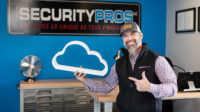How to Turn a $30 Monthly Customer into $100+ Monthly Customer
Increase your RMR through value-added managed video services without having to increase your customer volume.

In today’s security market it can be extremely difficult as a security dealer or integrator to truly differentiate yourself from your competitors, build and establish your unique brand, and remain sticky to your customer base. There is simply so much competition within the industry that everyone is basically saying “me too” and offering it for a few dollars less.
The challenges within the market from a client’s perspective are many: security systems are often seen as a necessary evil or as a way to comply with an insurance policy; alarm systems, cameras and DVRs/NVRs are basically sold as commodities; and, in most cases, key features are not even being utilized due to lack of training or awareness among the customers. The idea of “managed video services” is rarely being proposed. Business customers need solutions to key problems and are often uneducated as to what products and services are available to solve those problems, specifically regarding managed video services. That puts the onus — and the opportunity — on the security integrators to fully educate themselves and, in turn, their clients about what solutions are available to meet their needs — and that by being able to provide those solutions, makes them the best partner for their business.
Photo provided by Jason Caldwell
Managed video services allow the customer to get the most value from their overall security investment. They create a more proactive and interactive security solution as opposed to a tool that simply provides them with evidence after something bad has happened. They also help improve efficiencies and provide greater optimization of compliance and quality assurance issues, which are often as important as security. This greatly benefits the overall service level that a security dealer can provide to a client while, at the same time, enables the dealer to achieve previously unrealized recurring monthly revenue (RMR) streams.
Many industry experts have long agreed that the future of RMR growth is through video; however, the adoption rate among security dealers has been slower than expected and the market opportunity is still ripe. Millions of cameras are already deployed with no RMR services, so the low-hanging fruit is in plain sight, creating a low entry cost for many customers and minimal labor costs for security integrators.
Video RMR margins are typically anywhere from 30 percent to 100 percent per device or service; therefore, depending on the number of video devices at a given client location and the services being offered by the integrator, the revenue generated on that account can be dramatically increased with relative ease. This is the key formula to grow a traditionally monitored alarm account at $30 per month into a $100 per month, $200 per month or even $500 per month account.
You can clearly see the added revenue potential. The question for the security dealer then becomes, “How do I get into this market and begin to reap these benefits?”
First, the dealer must indoctrinate himself with the managed video services market. It is imperative to understand all of the services that are available, the value of each of service to the client, how to deliver the service and how to price the service.
The information contained in this chart broadly outlines the net revenue potential on a single installation, showing differences in average RMR rates between a typical monitored burglar alarm system and different types of managed video services.
Chart provided by Jason Caldwell
The most common managed video services include: video verification, remote guarding, video guard patrols, video escort or supervision, remote gate or door management, system health checks, operational or procedure audits, and cloud-hosted video storage.
Once the security dealer is properly educated on the market capabilities, it is then time to create his or her core offering — in other words, decide exactly which services you can realistically and effectively provide and build your business model upon those. Video verification and system health checks are typically the easiest services to deploy and usually do not require the dealer to add anything to a new installation or existing system other than the capability of a monitoring center or other entity to perform the service. Remote guarding relies on the camera system itself to act as a detection system and send alarms to a monitoring entity for real-time response. It is important in this case to utilize the right equipment (video analytics, etc.) so as to not create conditions where that monitoring center is forced to process excessive false or unwanted alarms. Remote managed gate or door services, along with video escorts or supervision and operational procedure audits, often involve longer, more labor intensive interactions and, in many cases, more detailed reporting. Therefore, it is imperative that you or your monitoring partner can deliver the necessary level of service.
There are several steps to consider in building such a core offering and each company that commits to the process will differ given their customer base. Some examples of these steps are as follows:
- Define a menu of services.
- Create packages that are simple to sell and understand.
- Price each service and make it profitable.
- Define monitored and nonmonitored services.
- Define which services require a monitoring partner and which can be direct to the client.
- Make it all scalable.
Once the security integrator has defined what his business model will be it is time to select the right products and partners to deliver the services. This will include a monitoring partner (unless the integrator has their own monitoring facility), camera vendors, VMS and NVR vendors, intrusion, access control and other software that may be needed to deliver the entire planned service offering.
The offering needs to be scalable. You should be able to walk down any main street or industrial boulevard in the country and have a core solution to offer nearly every business on that street. One effective way to enable this is to build three to five different solution packages that can be offered to the different macro-verticals (residential, small/medium business, commercial, enterprise) or specific target verticals that you may focus on. Eighty percent of a dealer’s managed video services offering should come from these solution packages.
The security dealer then must properly market the service offering to their customer base and make it a part of all new sales approaches with new prospects.
Some ways to achieve marketing success are to develop collateral material that’s easy to understand and start by mining your existing installed customer base and capturing that low-hanging fruit. Create a scripted visual-based sales tool to lead you through the sale and close. Build a campaign around a selected market you know well and target new prospects within that segment. And finally, offer to pilot a key client that you think can provide some influence in that vertical. Nothing sells solutions better than successful word-of-mouth.
Millions of cameras are already deployed with no RMR services, so the low-hanging fruit is in plain sight, creating a low entry cost for many customers and minimal labor costs for security integrators.
Photo provided by Jason Caldwell
No new product or service offering is successful without the right sales strategy and execution. Selling managed services requires a mindset change from what most security salespeople are accustomed to. Train and educate your sales team on video RMR services, markets and applications. Migrate them toward solution selling instead of equipment selling. Sell the service and the value from that service first, before you sell the product(s) that will make it possible. Make them ask the right questions to enable the presentation of the services right for the needs of the customer, whether that be add-ons to a proposed system or an entirely new and previously unconsidered solution. Sometimes just communicating your ability to provide evolving services allows for additional opportunities.
Another essential component will be to put the proper incentives in place for your sales team to successfully sell managed video services. This will help quicken that mindset change that is needed to build a successful and scalable program.
Finally, to keep a happy customer and to garner new customers, you must be able to execute your plan. Ensure the installation is simple and clean and done right the first time. Set clear expectations on the state of work (SOW) with the client. Ensure the standard operating procedures (SOP) and protocols are understood by the monitoring center. If necessary, conduct a soft-launch to ensure the defined protocols or SOP will be effective. Measure the results on a daily, weekly or monthly basis and communicate the results to the customer. Success is in the details.
If security dealers want to truly increase their RMR and the overall value of their businesses through managed video services, the strategy is to keep it simple. Remember the 80 percent rule and build your business model around it. Scalability is key. Become a partner to your customer, not just a vendor — create that stickiness. Understand, and by extension, help your client understand everything that video can do for them. Show them that it can be a complete system to alleviate operational, compliance and quality assurance issues, as well as security concerns. Remember that there are millions of cameras already deployed and the market is ripe with opportunity for add-on services as well as new sales and installations. A true company-wide commitment from leadership to sales to installation to back-end services will assuredly lead to success.
Looking for a reprint of this article?
From high-res PDFs to custom plaques, order your copy today!













